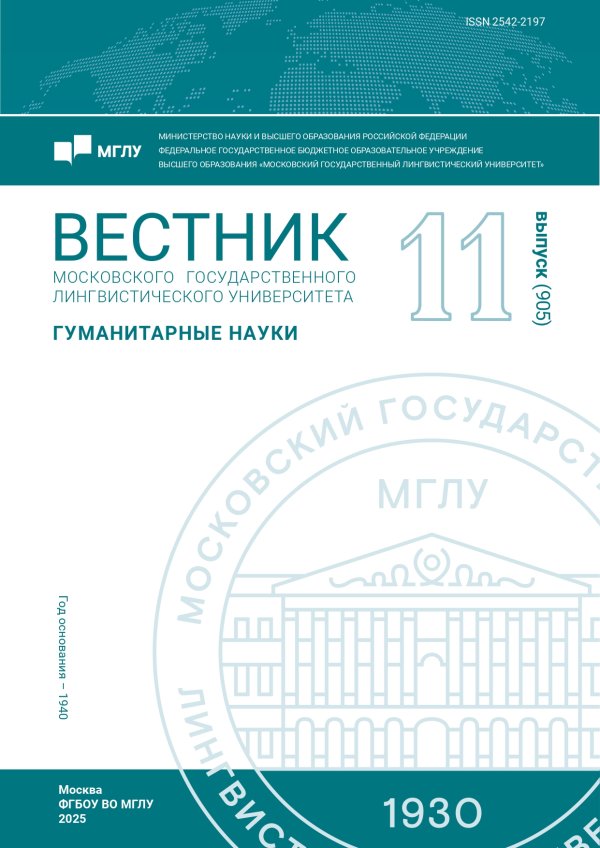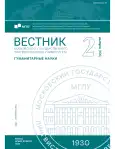К вопросу о выборе вспомогательного глагола в старофранцузском языке (на примере глагола aller)
- Авторы: Соловьева М.В.1, Хуторецкая О.А.1
-
Учреждения:
- Санкт-Петербургский государственный университет
- Выпуск: № 2(896) (2025)
- Страницы: 67-74
- Раздел: Языкознание
- URL: https://journal-vniispk.ru/2542-2197/article/view/283997
- ID: 283997
Цитировать
Полный текст
Аннотация
Цель исследования – выявить системно-языковые и дискурсивные факторы, влияющие на выбор вспомогательного глагола при образовании сложных временных форм глагола aller в старофранцузском языке. Материалом для исследования послужил подкорпус «Ancien français» корпуса французского языка «Frantext», включающий 75 разножанровых документов 1001–1299 годов объемом 2 813 707 слов. При работе с языковым материалом применялись методы контекстного и этимологического анализа. Установлено, что выбор вспомогательного глагола обусловлен как взаимодействием категориальных характеристик глагола aller (непредельность, непереходность) и дискурсивных факторов (наличие контекстуальных ограничителей, влияние языкового окружения), так и жанровой принадлежностью текста, его стилистической обработанностью.
Об авторах
Мария Владимировна Соловьева
Санкт-Петербургский государственный университет
Автор, ответственный за переписку.
Email: m.solovieva@spbu.ru
кандидат филологических наук, доцент, доцент кафедры романской филологии
РоссияОльга Александровна Хуторецкая
Санкт-Петербургский государственный университет
Email: o.khutoretskaya@spbu.ru
кандидат филологических наук, доцент, доцент кафедры романской филологии
РоссияСписок литературы
- Сичинава Д. В. Связь между формой и семантикой перфекта: одна неизученная закономерность // Динамические модели: Слово. Предложение. Текст: сборник статей в честь Е. В. Падучевой / под ред. А. В. Бондарко А. В. и др. М.: Языки славянских культур, 2008. С. 711–749.
- Сичинава Д. В. R. Aranovich (ed.). Split auxiliary systems. Amsterdam: Benjamins (Typological studies in language, 69), 2007. vii, 277 p. // Вопросы языкознания. 2010. Вып. 1. С. 126–133.
- Marchello-Nizia Ch. et al. Grande grammaire historique du français. Berlin – Boston: De Gruyter Mouton, 2020.
- Meigret L. Le Trętté de la grammęre françoęze. Paris, 1550.
- Arnauld A., Lancelot C. Grammaire générale et raisonnée, précédée d’un Essai sur l’origine et les progrès de la langue françoise / par M. Petitot, et suivie du commentaire de M. Duclos auquel on a ajouté des notes. 2me édition. Paris, 1810.
- Реферовская Е. А. К вопросу о выборе вспомогательного глагола для сложных форм французского языка // Ученые записки ЛГУ. Серия филологических наук. 1952. Вып. 156 (15). С. 256–264.
- Buridant C. Grammaire nouvelle de l’ancien français. Paris: Editions Sedes, 2000.
- Caudal P., Burnett H., Troberg M. Les facteurs de choix de l’auxiliaire en ancien français : étude quantitative // Le français en diachronie. Dépendances syntaxique, morphosyntaxe verbale, grammaticalisation / Ed. by S. Prévost, B. Fagard. Berne: Peter Lang, 2017. P. 237–265.
- Клейнер Ю. А. Язык поэтической традиции в синхронии и диахронии // Поэтика традиции: сборник научных статей. СПб.: Европейский дом, 2010. С. 18–45.
- Zumthor P. Essai de poétique médiévale. Paris: Seuil, 2000.
- Школьникова О. Ю. Семантические интенсификаторы признака субъекта в старофранцузском и старопровансальском языках (car, par, ben, ja, nemjas и другие): особенности функционирования. Вестник МГПУ. Серия «Филология. Теория языка. Языковое образование». 2022. Вып. 46 (2). С. 71–83. doi: 10.25688/2076–913X.2022.46.2.07.
- Сабанеева М. К. Художественный язык французского эпоса: Опыт филологического синтеза. СПб.: Издательство С.-Петербургского университета, 2001.
Дополнительные файлы











